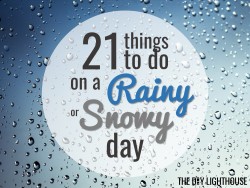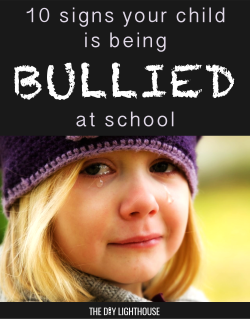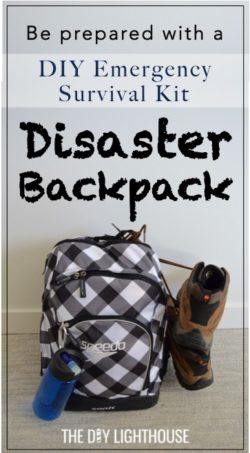 Earthquake, volcano, tsunami, flood, storm. The natural disasters I just listed are the ones most likely to happen in Seattle–where I live. And when I say, “most likely to happen,” I mean we are due any day for a big one. I had a moment of panic when I realized that if an emergency or natural disaster were to strike, my family would not be prepared in the least. As someone who loves my family dearly, this was a horrifying thought. So in a couple days I put together three emergency DIY disaster backpack kits (72 hour kit for emergency preparedness)–one for each person in my family.
Earthquake, volcano, tsunami, flood, storm. The natural disasters I just listed are the ones most likely to happen in Seattle–where I live. And when I say, “most likely to happen,” I mean we are due any day for a big one. I had a moment of panic when I realized that if an emergency or natural disaster were to strike, my family would not be prepared in the least. As someone who loves my family dearly, this was a horrifying thought. So in a couple days I put together three emergency DIY disaster backpack kits (72 hour kit for emergency preparedness)–one for each person in my family.
Although a natural disaster is still a scary thought, I am now a little comforted in knowing that I have the essentials to help my family should one strike. Below I will share with you what you should put in your DIY disaster backpack, a breakdown of what I put in my family’s DIY disaster backpacks, and tips for what to discuss during a family emergency preparedness meeting.
Why Have a Backpack Ready?
I chose to put everything in a backpack in case we are in a situation where we need to hurry and evacuate. You need to be prepared to grab-and-go. You will not have time to run around the house collecting things or run to the grocery store to buy things. If you have extra backpacks around the house that’s great! If not, head over to your local thrift store or Goodwill like I did and pick up some inexpensive ones.
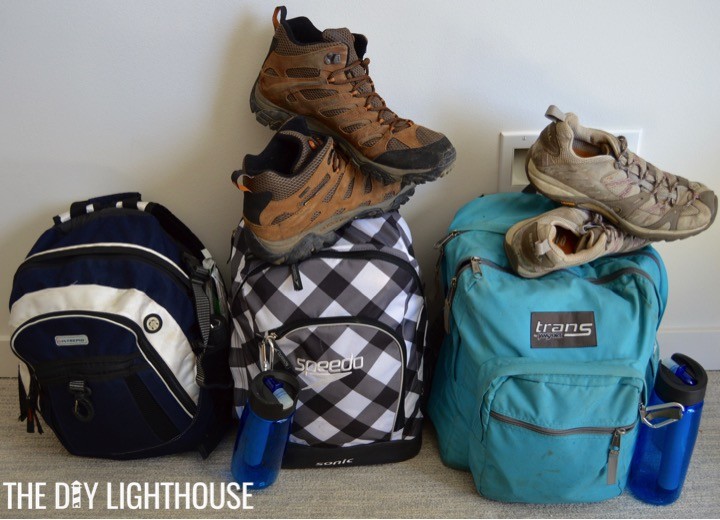
72 Hour Kit- DIY Disaster Backpack Essentials
(This page contains affiliate links that we may be compensated for. Your clicks and purchases help support The DIY Lighthouse at no extra charge to you. We only put links to products we love and would recommend anyway.)
1. Clothes
Have 1 full change of clothes in your DIY disaster backpack. This includes: hoodie/jacket, shirt, pants, underwear, socks, sturdy shoes, etc. Be sure to have your clothing be season appropriate. (If it’s the middle of the winter, you don’t want to only have a short-sleeved t-shirt.) You want sturdy, close-toed shoes because if a disaster happens you will likely be walking on uneven or dangerous surfaces. If you don’t have clothes that you can use on-hand then go to the thrift store and pick up some up for cheap.
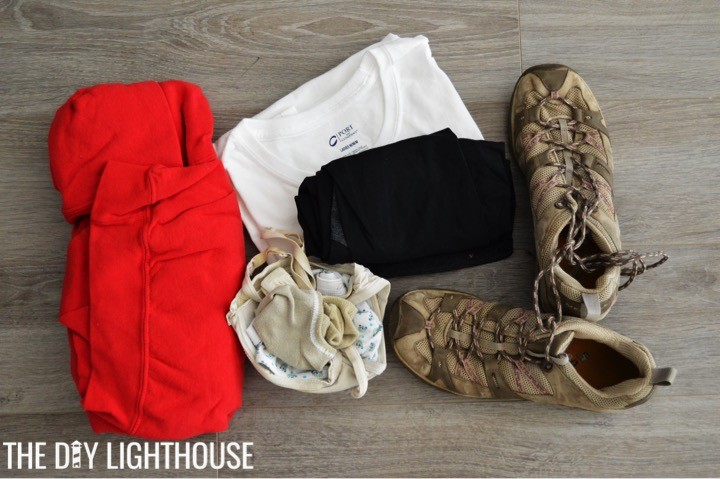
2. Hygiene/Bathroom
In your DIY disaster backpack, be sure to have a supply of everything you use on a daily basis. This could include: eye wear (backup glasses, glasses case, contacts, contacts case, contact solution), feminine products (tampons, pads, panty liners), toothbrush + toothpaste, hair ties, etc. It helps to get small, travel-sized versions of your bathroom supplies. (If you don’t have an extra one already, click here for a small bathroom travel kit.) The less space things take up and the lighter weight they are the better.
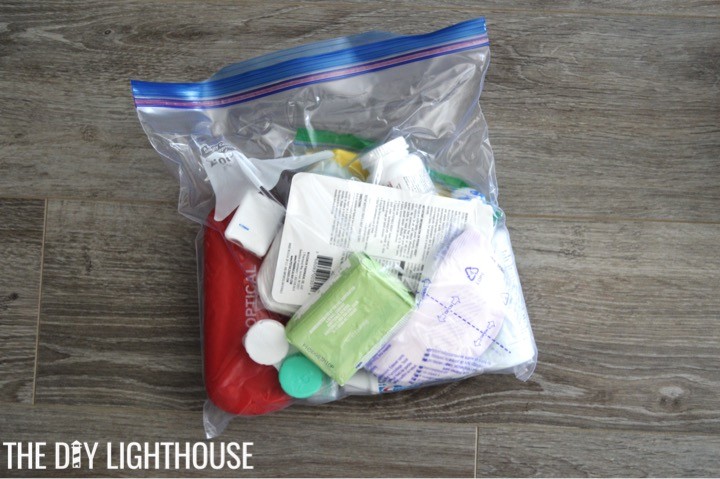
3. Sanitation
Be sure to pack some sanitation supplies in your DIY disaster backpack. This includes: travel-sized hand sanitizer, wet wipes, toilet paper, toilet wipes, and soap. In the event of a disaster, it is important to sanitize your hands so you don’t get sick and to sanitize any wounds so they don’t get infected. Remember that water is likely to be shut off or become contaminated during an emergency situation so you may not be able to rely on running water for sanitation needs.
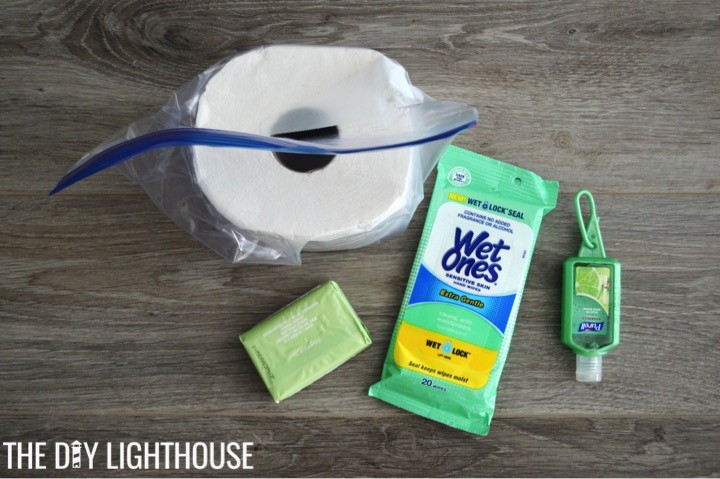
4. Water
Water is the most important! It is the most crucial piece to survival. You should plan on 1 gallon of water per person per day. Remember… In a natural disaster water pipes may brake and you may not be able to get any water out of your sink- and tub faucets, or water may become contaminated and unusable. Because water is so heavy, I could only put 6 plastic water bottles in my DIY disaster backpack. So to make sure we are water-ready, I also put a LifeStraw filtered water bottle and Potable Aqua water purifier tablets in my pack. (Note: I also store gallons of water in my pantry for emergency, but want to have some in my backpack for grab-and-go situations).
The LifeStraw is awesome! It removes E. Coli, Giardia, and other waterborne contaminants as well as 99.9% of waterborne bacteria and parasites from the water. This means you can fill up your water bottle with any water you find (like from a lake or pond), and you’ll be able to drink it and know you’re safe. (If you’re on a tight budget, click here to get a cheaper LifeStraw option that comes without the bottle.)
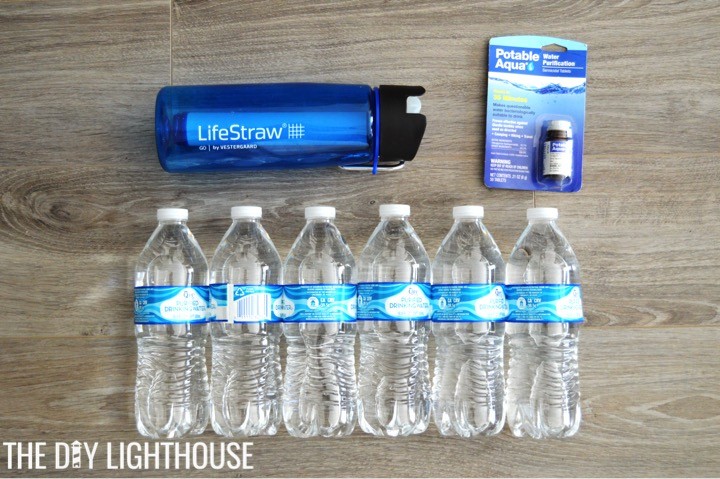
5. Food
In your DIY disaster backpack, pack enough food to last you 3 days. Think about packing high-calorie foods like peanut butter and granola bars. It is smart to pack food that you know you like and will eat. (I’ll eat just about anything so I got whatever was cheap at the store.) If you pack cans of food make sure you either buy the ones with the self-pop top (as shown on my can below), or make sure to also pack a can opener. I personally prefer more “regular” food, but if your pack does not have a lot of room and/or you want to avoid making it heavier, consider getting a couple of ER Emergency Ration bars. They will give you all the calories you’ll need to survive for a few days.
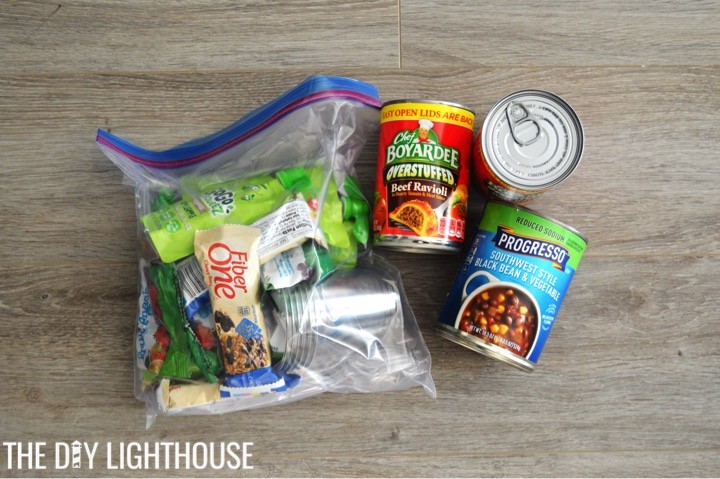
6. Medicine & Health
Pack a basic first aid kit and any medication you take in your DIY disaster backpack. (The I GO First Aid Kit that I got is a compact, light weight, and comprehensive option.) Also pack some Tylenol and/or Advil and any other medicine you think may come in handy for you. Just getting the store brand kind can save you a couple bucks.
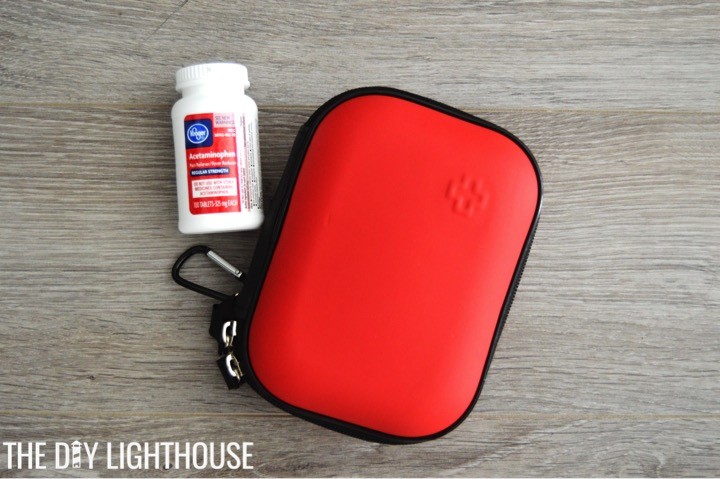
7. Emergency
The following items are the basic emergency essentials you should have in an emergency DIY disaster backpack: glow sticks, disposable gloves, a whistle, a thermal blanket, a rain poncho, a dust mask, waterproof matches, a flashlight, a radio, duct tape, a pocket knife, and needle nose pliers. You can typically get inexpensive needle nose pliers and duct tape at Goodwill or the dollar store, but I ordered the other supplies on Amazon. I did research and would recommend the following options for your emergency supplies…
- Glow Stick: Cyalume SnapLight Green Light Sticks, Industrial Grade Ultra Bright Glow Sticks with 12 Hour Duration. These are no-joke-around glow sticks that are military-grade. This is good light source during a power outage for illuminating an area. (I put 3 in my pack.)
- Disposable Gloves: Nitrile Medical Grade Exam Gloves will come in handy for tending to any injuries or wounds that may result from a disaster. They are also nice to have for keeping dirty hands away from meal prep/eating, when dealing with unsanitary bathroom duties, etc.
- Whistle: Shoreline Marine Emergency Survival Whistle. This will blow when wet or dry and is very loud. Great way to call for help after a disaster or emergency situation.
- Thermal Blanket: Emergency Mylar Thermal Blankets are very compact and lightweight but provide excellent warmth in all weather conditions. (I put 2 in my pack.)
- Rain Poncho: MCR Medical Disposable Rain Poncho with Hood is lightweight, compact, and waterproof.
- Dust Mask: 3M 8511 Particulate N95 Respirator with Valve is the fancy name for dust mask. This mask protects against airborne dirt, drywall dust, or smoke or paint particles. This is good for protecting your lungs from situations like an earthquake where a lot of dust is in the air.
- Waterproof Matches: Coghlan’s Waterproof Matches
- Flashlight (and Radio): Safe-T-Proof Solar & Hand-Crank Flashlight +Emergency Radio/Beacon/Cell Phone Charger and/or Cynergy Lifelight All-in-One Waterproof Emergency Crank Flashlight +Window Breaker/Seatbelt Cutter/Compass/USB Cell Phone Charger/Red Light Flasher. Both options are really comprehensive and require no batteries. (I got both… the first one for my husband’s pack and the second one for my pack. For my baby’s pack I picked up a simple flashlight from Goodwill.) In a disaster the power will mostly go out and you’ll definitely need a good flashlight. Having a flashlight with a built-in radio is good so you can tune-in and listen to news about the disaster, the city’s situation, or any instructions on how to proceed.
- Duct Tape: Really? Yes. This will come in handy for multiple disaster situations: securing medical wraps, constructing a makeshift tent, fixing ripped clothes, etc. (Good thrift store purchase.)
- Pocket Knife: My husband had one handy that we used, but here is an option. (Good thrift store purchase.)
- Needle Nosed Pliers: These are good to have so that you can turn off your water, etc. in an emergency. (Good thrift store purchase.)

8. Miscellaneous
Pack some other miscellaneous items that could come in handy during a disaster. Example: twisty ties, garbage bags, gallon Ziplock bags, a pencil and paper, etc. Be sure to also have a copy of important papers like your insurance policy, bank account information, id/passports, etc. in a sealed bag for protection.
9. Baby/Child (if applicable)
If you have a baby or small child, then you will need to adjust their pack to fit their needs. Things you may need: diapers for 3 days (if you can, go a size up then what they are currently in), baby Tylenol, formula, and a little bag of small toys. Toys may seem unnecessary to you, but if you are in a post-disaster situation then you’ll want to have something that will help entertain and comfort them. I picked up some inexpensive, small toys at Goodwill, but kid binoculars are also a fun, versatile idea for imaginative play.
My Family’s DIY Disaster Backpack Contents
 When separating out my family’s supplies, I tried to make it so that both adults had their essentials but we split up some of the other supplies. For example, my pack had the toilet paper roll, water purifier drops, and first aid kit, while my husband’s pack had the duct tape roll, needle nose pliers, and pocket knife.
When separating out my family’s supplies, I tried to make it so that both adults had their essentials but we split up some of the other supplies. For example, my pack had the toilet paper roll, water purifier drops, and first aid kit, while my husband’s pack had the duct tape roll, needle nose pliers, and pocket knife.
My Emergency DIY Disaster Backpack
- Clothes: hoodie, t-shirt, pants, socks, bra, underwear, hiking boots
- Hygiene/bathroom: eye wear (backup glasses, glasses case, contacts, contacts case, contact solution), feminine products (tampons, pads, panty liners), toothbrush + toothpaste, razor
- Sanitation: hand sanitizer, wet wipes, 1 roll toilet paper, 1 bar soap
- Water: 6 water bottles, water bottle w/filter, water purifier drops
- Food: 3 cans, 6 granola bars, 6 fruit snacks, 6 apple sauce packs, cups + spoons
- Medicine/emergency: Tylenol, first aid kit, 3 glow sticks, 4 disposable gloves, 1 whistle, 2 thermal blankets, 1 rain poncho, 1 hand crank flashlight/radio, 1 dust mask, waterproof matches
- Misc: twisty ties, 2 garbage bags, 1 gallon bag, 1 pencil, sticky notes, copy of important papers (insurance policy, bank account info, id/passports) in a sealed bag
My Husband’s Emergency DIY Disaster Backpack
- Clothes: pants, shirt, socks, underwear, hiking boots
- Hygiene/bathroom: toothbrush + toothpaste, toilet wipes, deodorant, razor
- Sanitation: hand sanitizer, soap bar
- Water: 6 water bottles, 1 water bottle w/filter
- Food: 1 jar peanut butter, 3 cans food, 6 granola bars, 6 fruit snacks, 6 apple sauce packs, cups + spoons
- Medicine/emergency: Benadryl, Ibuprofen, 1 roll duct tape,1 switch knife, needle nose pliers, 3 glow sticks, 4 disposable gloves, 1 whistle, 2 thermal blankets, 1 rain poncho, 1 hand crank utility flashlight, 1 dust mask, waterproof matches
- Misc: twisty ties, 2 garbage bags, 1 gallon bag, cash, copy of important papers (insurance policy, bank account info, id/passports) in a sealed bag
My Baby’s Emergency DIY Disaster Backpack
- Clothes: pants + shirt (size 4T), socks
- Hygiene/bathroom: toothbrush + toothpaste, toilet wipes, 20 diapers (size 3)
- Sanitation: hand sanitizer
- Water: 6 water bottles
- Food: 3 cans food, 6 granola bars, 6 fruit snacks, 6 apple sauce packs, cups + spoons
- Medicine/emergency: baby Tylenol, 3 glow sticks, 4 disposable gloves, 1 whistle, 2 thermal blankets, 1 rain poncho, 1 flashlight, 1 dust mask
- Misc: 1 bag toys, 2 garbage bags, 1 gallon bag, copy of passport in a sealed bag
Family Emergency Preparedness Meeting
Once your emergency DIY disaster backpacks are put together, have a family meeting so you are all on the same page. Review the contents of each pack with your family members. Then, put your DIY disaster backpacks in a easy-to-access place preferably near the door (so you can grab-and-go in an emergency if needed) and make sure everyone knows where to find them. Come up with a meeting place that is just outside your home that you will use if an disaster/emergency should occur. Also come up with a secondary meeting place that is just outside your neighborhood in case getting to the first meeting place is not an option. Remember to factor in variables like the garage door won’t open and/or the elevator doesn’t work (which happens when the power goes out), cell phones don’t work, etc. These are all very likely to happen in the event of a disaster. Lastly, practice your emergency plan.
Note: Be sure to update your DIY disaster backpacks regularly so that you have the right size clothes/diapers and so the food, water, medicine, etc. is not expired.
